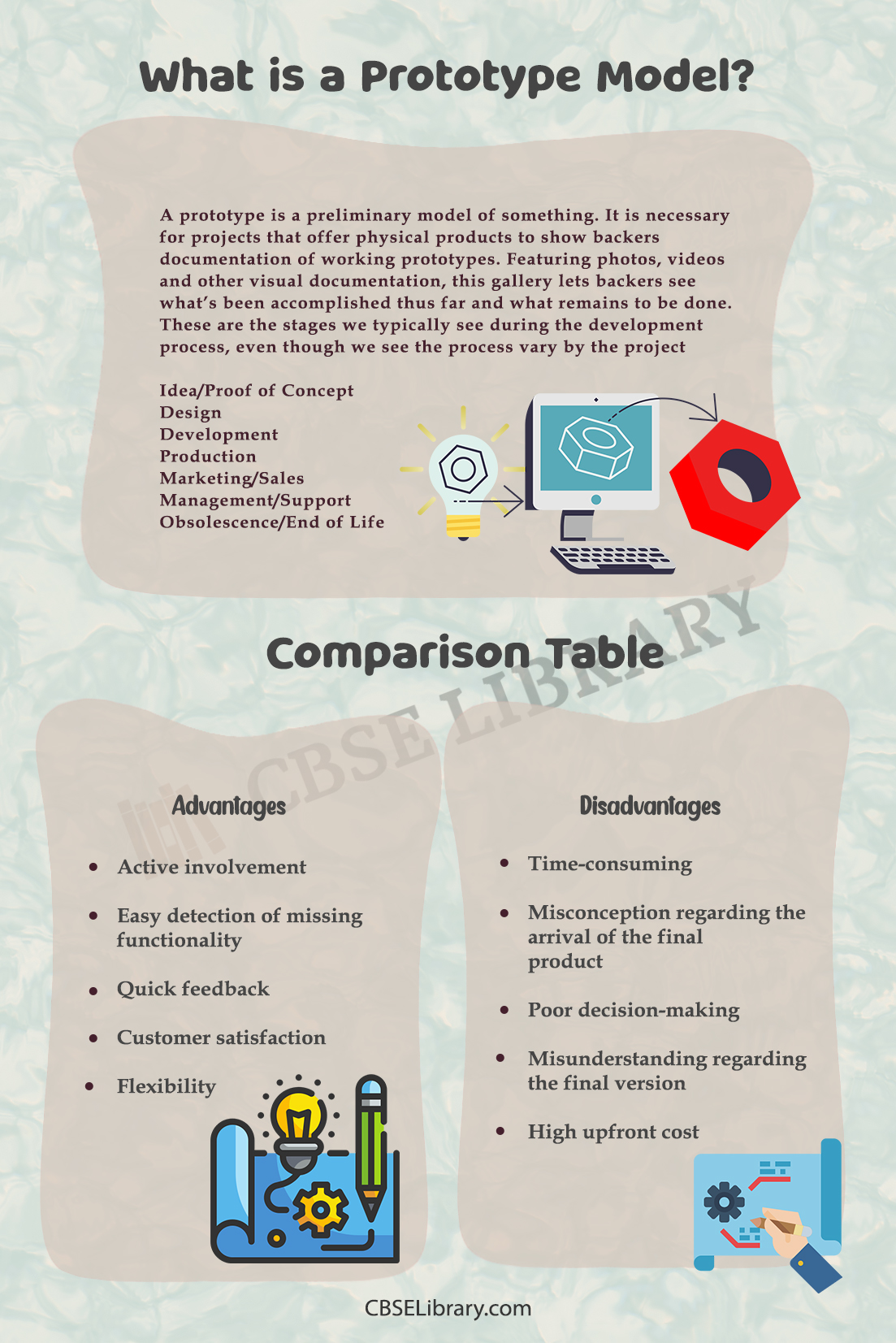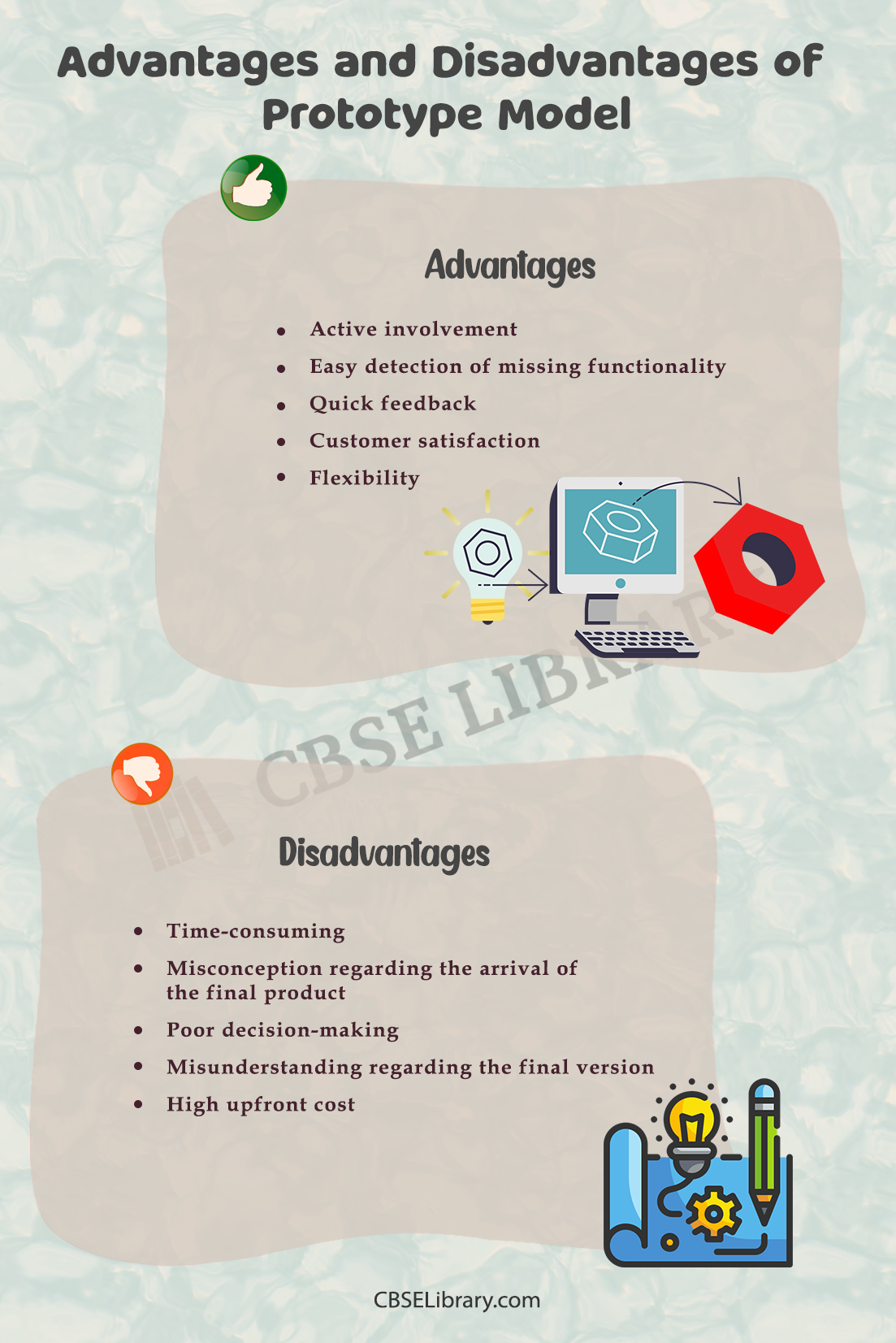Prototype Model Advantages And Disadvantages: While the prototype model has many benefits, there are also some notable disadvantages that you should keep in mind before you decide to move forward with this business model. The following are some of the biggest pros and cons of this approach.
Students can also find more Advantages and Disadvantages articles on events, persons, sports, technology, and many more.
What is a Prototype Model?
A prototype is a preliminary model of something. It is necessary for projects that offer physical products to show backers documentation of working prototypes. Featuring photos, videos and other visual documentation, this gallery lets backers see what’s been accomplished thus far and what remains to be done. These are the stages we typically see during the development process, even though we see the process vary by the project:
- Idea/Proof of Concept: An initial description of your idea.
- Design: Drawings, diagrams, or prototypes of your idea (and a preliminary budget).
- Development: Detailed design drawings, engineering specifications, and an extensive budget plan (and timeline).
- Production: Creation of process-related information such as material sources and suppliers, manufacturing methods, etc.
- Marketing/Sales: Completion of a business plan; launching your product or service (and beginning to sell it).
- Management/Support: Continuing sales growth through marketing and customer support; ensuring customer satisfaction.
- Obsolescence/End of Life: Post-sales support through warranty programs, customer service, technical assistance, parts sales or recycling programs; continuing development for follow-on products or services (if applicable).
The Advantages and Disadvantages are listed below in points form!
- Advantages of Prototype Model
- Disadvantages of Prototype Model
- Comparison Table for Prototype Model Advantages And Disadvantages
- FAQ’s on Prototype Model Advantages And Disadvantages
- Conclusion on Prototype Model Advantages And Disadvantages

Advantages of Prototype Model
A prototype model is a scale model that is used for manufacturing before mass production. First developed in aviation, it has since been adopted by other areas including car manufacturing. A prototype model can be almost any size or shape. They are often made from wood or steel. They have the following advantages:
- Active involvement: The advantage of a prototype model is that it allows for active involvement in testing its effectiveness. This means that you can get feedback from people who will be using your product, helping to improve its design before mass production begins.
- Easy detection of missing functionality: Another advantage is that a prototype model allows you to detect any missing functionality during testing, making it easier to identify problems before mass production begins. This helps to avoid costly mistakes later on in your project.
- Quick feedback: The advantage of a prototype model is that it can provide quick feedback on your product, helping you to make improvements before mass production begins. This means that you can save time and money by avoiding mistakes later on in your project.
- Customer satisfaction: The advantage of a prototype model is that it can help to increase customer satisfaction with your product, as you will be able to test it before mass production begins. This means that you can make improvements before your product hits the market, which can help to boost sales.
- Flexibility: The advantage of a prototype model is that it allows you to make changes to your product quickly, which can help to save time and money. This flexibility means that you can adapt your product to changing market conditions, helping you to stay ahead of your competitors.
Disadvantages of Prototype Model
While the prototype model is useful in innovation, there are certain disadvantages as well. Some of them are as follows:
- Time-consuming: The process of a prototype model is time-consuming as it requires a lot of effort to be put in by different departments. The process can take weeks or months depending on how large or small your project is. It is impossible to change anything once you have started with the prototype model, which makes it even more difficult for people working on it as they cannot improvise their work if required.
- Misconception regarding the arrival of the final product: One of the biggest disadvantages of a prototype model is that it creates a misconception in people’s minds about how the final product will look like. They assume that once they have made a prototype, then their job is done, but in reality, it is just one step towards making your final product!
- Poor decision-making: Since a prototype model is time-consuming, it can also affect your decision-making skills. If you are looking for an efficient solution to your problem, then it would be better to go with another model as a prototype model may not help you make decisions quickly!
- Misunderstanding regarding the final version: Another disadvantage of a prototype model is that it can lead to misunderstandings between people as they might assume that their prototype model is exactly how their final product will look like! This is not true at all, so it would be better to keep such misunderstandings in mind while working on a prototype model!
- High upfront cost: The biggest disadvantage of a prototype model is that it has a high upfront cost as it requires a lot of effort to be put in by different departments! This means that you would have to spend more money on your project if you are working on a prototype model, which can be quite an inconvenience for many people!
Comparison Table for Prototype Model Advantages And Disadvantages
| Advantages | Disadvantages |
| Active involvement | Time-consuming |
| Easy detection of missing functionality | Misconception regarding the arrival of the final product |
| Quick feedback | Poor decision-making |
| Customer satisfaction | Misunderstanding regarding the final version |
| Flexibility | High upfront cost |

FAQ’s on Prototype Model Advantages And Disadvantages
Question 1.
What is a prototype model?
Answer:
A prototype model is a physical representation of a design or idea that can be used to test it before making it available for sale. The word prototype comes from Greek, meaning first-moulded or original pattern; in general, prototypes are created as part of an iterative process by which designers improve upon their original idea, creating new models with each iteration until they arrive at a final product that meets all requirements for sale.
Question 2.
Where is the prototype model used?
Answer:
A prototype model is used in a variety of industries, including industrial design, engineering, and architecture; it can also be used to test a design before investing in full-scale production.
Question 3.
What are the 2 types of prototype models?
Answer:
There are 2 types of prototype models: a working model, which is used to test how well a design works in real-world conditions, and a non-working model, which can be used to demonstrate how something will look but not how it will function.
Question 4.
How do you make a prototype model?
Answer:
There are a number of different ways to make a prototype model, including 3D printing, CNC machining, injection molding, and more; you can also create an inexpensive mock-up by hand if you don’t have access to these technologies.
Conclusion on Prototype Model Advantages And Disadvantages
Prototype models are a proven approach to understanding user behavior. Their detailed functionality emulates a real experience, which is especially beneficial when trying to understand how users with low digital literacy or technical aptitude might use an interface. When planning your prototypes, keep in mind that there are both advantages and disadvantages to each of these methods.